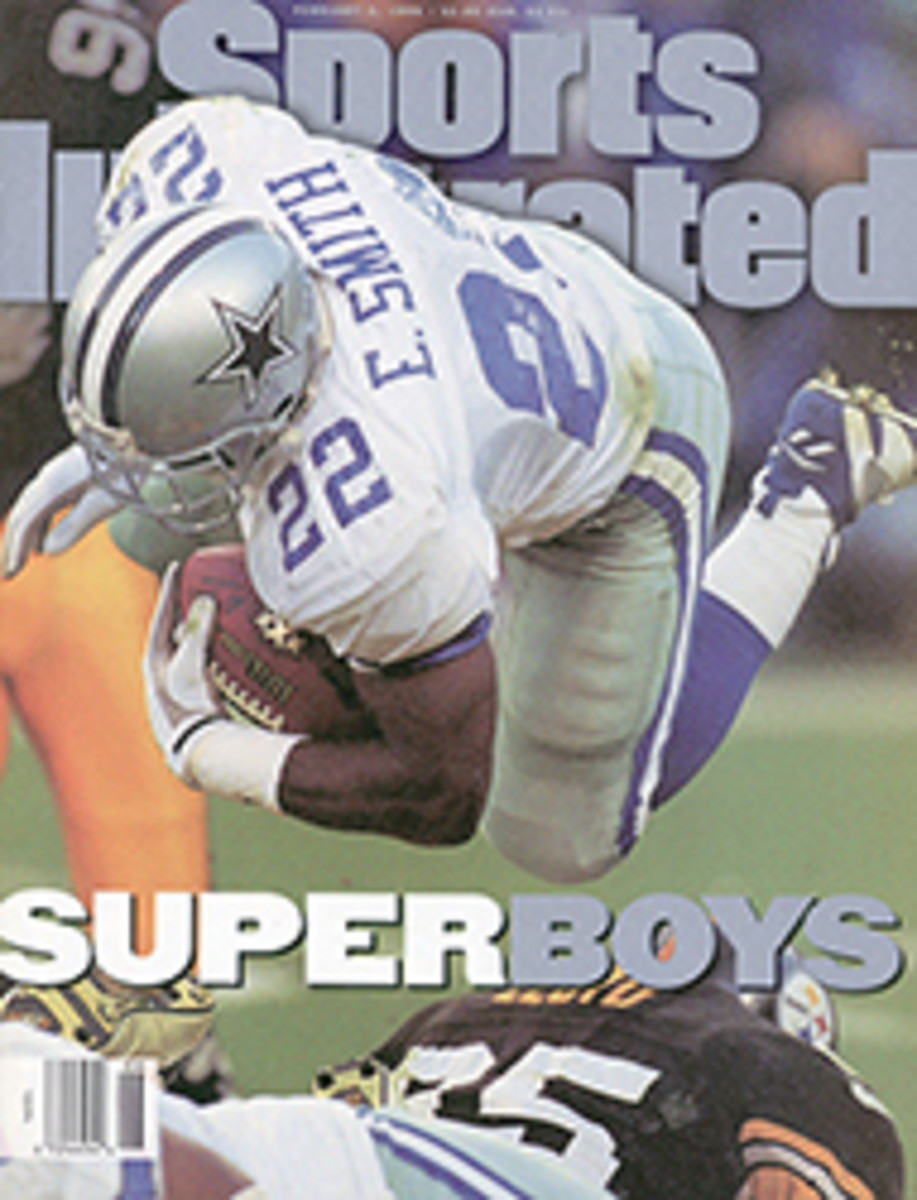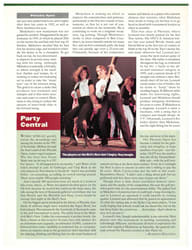
RICH LEGACY KARSTEN SOLHEIM HAS HANDED HIS ONCE OMNIPOTENT PING DYNASTY OVER TO HIS SONS
For years he was way ahead of the curve, but the years and the
curve finally caught up with him. Karsten Solheim--his name is as
famous as his little white beard--is 84 years old now. His Ping
irons were once considered radical, but now everybody is copying
his perimeter-weighted, cavity-back design. His family-owned
company, Karsten Manufacturing Corporation of Phoenix, is still
a dominant player in the golf business. And Solheim, according
to Forbes, remains one of the 400 richest people in the country.
But business is not as it was. Last year, for the first time
since 1983, Ping, according to an independent and highly
regarded survey, was not the game's top-selling iron. It was
second, to Cobra. Something had to give. In June, Solheim
relinquished control of his company, but only after one of his
three sons asked for the reins.
To Ping's boosters, the No. 2 ranking is temporary and a
statistical blip, but the underlying fact is that Ping's 1995
sales ranking would have been lower were it not for the
continued success, 14 years after its introduction, of the Eye2
iron.
Merchandisers still speak reverentially about the sales of the
Eye2. During the golf boom of the middle and late 1980s, the
Eye2 was the club of choice, and it is regarded as the
best-selling iron in the long history of iron-selling. But the
competition has caught up. A club professional who made
college-tuition payments on his Ping commissions during the
Reagan years said recently, "Ping is a nice club. Cobra makes a
nice club. The Armour club is good. Wilson, Callaway,
Titleist--they're all making good clubs now."
In hotel bars at golf trade shows, industry watchers seem to
enjoy speculating on Karsten Manufacturing's problems, or, more
accurately, perceived problems. (The tone of pettiness is rooted
in the fact that the company has never been part of golf's
old-boy network. Solheim doesn't drink or hang out, and his
roots are in engineering, not golf. He's viewed as an outsider
and a renegade, and so is his company.) Industry insiders cited
Karsten Manufacturing's disputes with the PGA Tour, the USGA and
the Royal & Ancient over what constitutes a conforming club and
how the feuds and consequent lawsuits distracted Solheim from
club design. They listed the marquee players Karsten no longer
has under contract, including Mark Calcavecchia, John Daly and
Bob Tway, each of whom won a major championship playing Pings.
They chided the company's guileless, homemade advertising
campaigns. They questioned Solheim for his apparent reluctance
to turn over day-to-day control of the company to the next
generation.
Last year, for the first time since 1968, Karsten Manufacturing
had layoffs. One hundred nine employees were fired, reducing the
working population at Karsten to 1,700. "Our orders had fallen
some," says Allan D. Solheim, a Karsten Manufacturing personnel
executive and the second of Karsten and Louise Solheim's three
sons.
The widely held belief was that one day either Allan or his
older brother, Karsten Louis, or their younger brother, John,
would be named as president of the business, but nobody knew
which brother it would be or when the transition would come.
(The Solheims' married daughter, Sandra Aiken, was not
interested in the position.) The subject of succession was not
discussed openly, not at board meetings, not at family dinners.
The brothers were candidates for a job for which there was no
apparent application process and no known timetable. Families
have been rendered dysfunctional with far less at stake, but the
three brothers knew the viability of the company depended on
orderly change. Without saying a word, they pledged cohesion.
They wanted Karsten Manufacturing to remain a family company.
In considering his three sons, Solheim did not lack for variety.
Allan, 55, is a marathon runner, a sporadic but intense golfer,
a horseman and a statesman, of a kind. A friendly and warm man,
he merrily hands out business cards that identify him as a
consul of Norway, an honorary governmental position he relishes
(Karsten Solheim was born in Norway), and he likes to wear
brightly colored sweaters, many of which he buys on his frequent
trips there.
Louis, 58, is a very occasional golfer and a devout Christian
who lives, despite his family's immense wealth, in the heart of
suburban, middle-class Phoenix. He was trained as an engineer,
as was his father, and, in his somber-colored cardigans and
glasses, exudes a professorial manner. Like his father, he sees
any topic's potential for complexity. Describing his father's
business philosophy, for example, Louis says, "He would never
say his goal was to build the best golf club, or make the most
money, because the goal was never any one thing. Once you
thought you had the goal trapped in a corner, it moved. The goal
was undefinable and ever-changing."
Then there is John, 50, corpulent, broad-faced and
white-bearded--and a devout golfer. He has worked for his
parents since he was a teenager. He has a pool shaped like a
sand wedge--a Ping sand wedge, he points out--and there's a
mural on his living room wall depicting the 16th hole at the
Cypress Point Club, the famous across-the-Pacific par-3 on the
California coast. Like many workers at the plant, he usually
wears a Ping sweater and under it a Ping shirt.
In time one of the sons received the job. But only after he
formally requested it.
At a board meeting last June, and with no advance notice to
anyone in the room, John said, "I would like to nominate [my
father] Karsten as chairman of the company, and I would like
Karsten to nominate me as president." His father did so. Allan
seconded the nominations. The vote was unanimous. The
transition, a decade in the making, was completed in several
minutes. It was a board meeting that marked, for the first time
in 37 years in business, decisive generational change. At the
same meeting Louis was named president of Karsten Engineering, a
division of Karsten Manufacturing, and Allan was named executive
vice president of Karsten Manufacturing. All this may seem like
an uncommon way to do big business, but the uncommon is normal
at Karsten.
For instance, the company does not give players guaranteed
contracts for using its clubs. Instead, players are paid after
the season, in direct correlation to how they played. That is
unheard of in golf marketing today, and it is why Karsten
Manufacturing has lost its better-known players. John Solheim
says one of his first tasks will be to figure out a way for the
company to retain its established players, such as Jeff Maggert,
Billy Mayfair, Cindy Rarick and Val Skinner. (Karsten's
involvement in women's golf goes far beyond its sponsorship of
the Solheim Cup.) He won't, however, pay them, or anybody else,
in advance. "We've always felt we should have players who want
to play our clubs," John says. "That won't change."
Other companies would be eager to sign up Mayfair and would pay
him a guaranteed contract that would not depend on his
performance. They would happily give him close to the estimated
$750,000 he earned by playing Ping clubs last year when he
finished second on the money list with $1,543,192. Mayfair is
not interested in making a change. "Guarantees are nice, but
playing hard is the best," he says. "I like that the Ping system
is performance-driven. For me, they're the best clubs being
made, and that's the thing that matters most."
Tway burst onto the scene in 1986 when he won the PGA
Championship and three other events using the cavity-back Pings.
There was, he says, some resentment from old-guard players about
his futuristic-looking irons, but that's not why he left the
company. Later, when the USGA said certain Eye2 irons were
illegal because of their groove design--a ruling it later
rescinded--Tway again felt uncomfortable about using Pings. But
he didn't leave because of that, either.
He left Karsten because he found the company's policies too
dogmatic. He didn't always want to use a Ping putter, but he had
to if he wanted to be eligible for the company's postseason
bonus pool. He liked the idea that other companies were willing
to pay him a guaranteed amount. "There's enough uncertainty in
this game," says Tway. Who knows what the fortunes of Karsten
might be today if Tway and Calcavecchia and Daly, not to mention
Fred Couples, Ernie Els, Nick Faldo and Phil Mickelson, among
many others, had stayed with Ping clubs. Presumably, by spending
enough money, Karsten could have kept at least some of them.
Though the Solheims do not do things out of a business-school
textbook, neither are they people who pay no attention to the
world as it is. John has seen what intensive advertising
campaigns have done for companies like Callaway. He knew that
time had passed by Ping's homemade advertisements. One of his
first moves as president was to sign up an advertising agency,
the Martin Agency of Richmond.
The agency's first advertisements are coming out now, and their
purpose is to promote the new Ping iron, the ISI. The copy on
one advertisement reads, "For 37 years, the Solheim family has
gone to work and said, 'How can we make a better golf club?'
Recently, they had a particularly good day at the office." At
the bottom of the ad is a picture of Karsten Solheim, of course.
There always is. Standing beside the founder, and a half head
above him, is John. The ISI is John's child, his first iron.
"It's the next generation from the next generation," reads the
copy.
The club, like the ad agency, is somewhat of a departure for
Ping. For one thing, John emphasized aesthetics in the club's
design. As a designer, Karsten Solheim's primary consideration
was function. The club is also being offered in an oversized
model, the ISI K, although oversized is a word the Solheims
distance themselves from, a word they associate with the
marketing ploys of other manufacturers. These days club-buyers
want a choice, John says. So Karsten is giving customers what
they want, not just what they need.
Late on a recent weekend night, John was sitting at home,
talking about his company. His three sons were running in and
out of the house. His plant, four miles away, was filled with
ISI club heads waiting for shafts and grips and players to swing
them. His father was just down the hill, in his own house. Maybe
he was asleep. Maybe he was awake, paper and pencil in hand,
drafting, jotting things down. The father believes the perfect
golf club hasn't been designed yet. The son feels the same way.
All the ISI is, John Solheim says, is the best so far.
COLOR PHOTO: JOHN D. MCDONOUGH Solheim has a gilded Ping putter stored in a vault for each victory earned with the club worldwide. [Karsten Solheim holding gold golf club while sitting in front of vault filled with gold golf clubs]
COLOR PHOTO: DAVID E. KLUTHO Tway (bottom) chafed at Ping's endorsement rules, but Mayfair made the system work in his favor. [Bob Tway]
COLOR PHOTO: ROBERT BECK[See caption above--Billy Mayfair]
COLOR PHOTO: JOHN D. MCDONOUGHJohn, whose pool advertises his allegiance, has joined Dad as a key man in the marketing swim (top). [Swimming pool shaped like sand wedge]
COLOR PHOTO [See caption above--John Solheim and Karsten Solheim in PING golf clubs advertisement]

